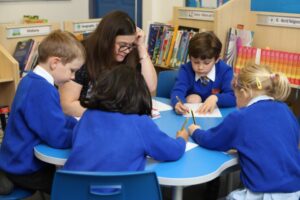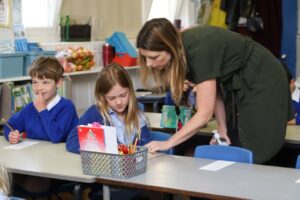Writing Curriculum Intent Statement
Why is writing so important?
Learning to write is one of the most important things that a child at primary school will learn. Children use their writing in almost all other subjects of the curriculum. Good writing also gives children a voice to share their ideas with the world.
For a child, learning to write can be a tricky business, not least because good writing involves handwriting, spelling, grammar and punctuation not to mention what we want to write and who we are writing for.
Writing in the National Curriculum
The programmes of study for writing at key stages 1 and 2 are constructed similarly to those for reading:
We believe it is essential that our teaching develops pupils’ competence in these two dimensions. In addition, pupils should be taught how to plan, revise and evaluate their writing.
Writing down ideas fluently depends on effective transcription: that is, on spelling quickly and accurately through knowing the relationship between sounds and letters (phonics) and understanding the morphology (word structure) and orthography (spelling structure) of words.
Effective composition involves forming, articulating and communicating ideas, and then organising them coherently for a reader. This requires clarity, awareness of the audience, purpose and context, and an increasingly wide knowledge of vocabulary and grammar. Writing also depends on fluent, legible and, eventually, speedy handwriting.
Writing and inspiration.
 To make writing relevant there must be a purpose, inspiration and a desire to communicate. Especially in Early years and lower KS1 we give opportunities to develop writing through play. Writing for a real-life purposes is a great way of practising writing. Writing cards, shopping lists, or letters to relatives can all be motivating real life reasons for writing and ways of developing key skills.
To make writing relevant there must be a purpose, inspiration and a desire to communicate. Especially in Early years and lower KS1 we give opportunities to develop writing through play. Writing for a real-life purposes is a great way of practising writing. Writing cards, shopping lists, or letters to relatives can all be motivating real life reasons for writing and ways of developing key skills.
Pupil interviews show that our children love to write, because they are provided with inspiring stimuli. Many of our writing topics are inspired from our reading of class novels, inspirational texts or other subjects such as history topics or school visits and residentials. As a result of this most of the written work that takes place is of a cross curricular nature.
Writing at Harewood is taught in a variety of ways depending on the age of the children and the text type being studied but the basic principles are always the same. Children are provided with an inspiring stimuli and a purpose/audience for their writing. They examine high quality examples of similar texts and as the children progress through school they are taught to analyse a text for key features.
When writing the children are given opportunity to plan their ideas and draft writing. Children are encouraged to self-assess their writing against success criteria and then, these initial drafts are then worked upon to make improvements with the aid of peer support and teacher input.
Spelling
 While there’s obviously much more to good writing than correct spelling, if children are worrying about spelling a particular word or having to stop frequently to think about spelling it can prevent them from concentrating on the other aspects of writing.
While there’s obviously much more to good writing than correct spelling, if children are worrying about spelling a particular word or having to stop frequently to think about spelling it can prevent them from concentrating on the other aspects of writing.
Good phonics skills are essential to being a good reader and speller. Reception and Key Stage 1 classes have daily phonics teaching to develop these skills. The phonics scheme used by school is based on the Letters and Sounds scheme which is supported with resources from Twinkl phonics. Other resources used by staff include a range of interactive websites to bring the learning to life in a visual and stimulating way.
As well as learning phonic spelling our children follow sequenced spelling lists which teach the patterns required to fulfil the requirements of the National Curriculum. In KS1 these are based around lists which help the children learn the different ways of spelling similar sounds linked to the phonics teaching. In KS2 spelling lists include patterns within words and revision of previous learning.
When teaching spelling our children learn about spelling patterns, rules and the etymology of words to aid understanding of the ways words are constructed in the English Language.
Handwriting
Fluent, neat handwriting is useful to ensure that a reader can understand what a child is trying to communicate in their writing, as well as helping a child to feel confident about their writing. From Foundation Stage our children are helped to have correct pencil grip and form letters correctly. Poor grip and incorrect letter formation quickly becomes a habit which is difficult to overcome latter.
As well as giving a good first impression to the reader, a confident, fluent handwriting style contributes to reading and spelling fluency because it improves visual perception of letters. In later school life including Key Stage 2 many assessments are based on written work and include time-limited written tests. Without fast and legible handwriting, students will miss out on learning opportunities, under-achieve and may fall behind.
In Years 5 and 6 children who have demonstrated consistent joined handwriting will be awarded a ‘Pen Licence’. This means they are awarded a pen to use when writing. However to ensure the standards are maintained these licences need renewing at the start of each school year.
Grammar
 Recent years have seen the profile of grammar become more prominent. At Harewood children learn the required aspects of English grammar as part of writing sessions but also in specific grammar lessons. We teach the grammar skills to be able to structure quality writing and so that our children are familiar with the terminology and vocabulary associated with English grammar. This is important if the children are to be able to accurately analyse and describe features of their work as well are attaining well in Grammar assessments.
Recent years have seen the profile of grammar become more prominent. At Harewood children learn the required aspects of English grammar as part of writing sessions but also in specific grammar lessons. We teach the grammar skills to be able to structure quality writing and so that our children are familiar with the terminology and vocabulary associated with English grammar. This is important if the children are to be able to accurately analyse and describe features of their work as well are attaining well in Grammar assessments.
Use of ICT to support writing.
While writing using a pen and pencil is essential, writing on the computer counts too. We often use ICT as a way of communication our ideas in the form of written work and this type of writing is a fabulous way of enabling and practising redrafting and editing.
Assessment of Writing
Assessment is not just used to track children’s learning but also provides teachers with up-to-date and accurate information about the specifics of what children do and do not know. This information allows teachers to adapt their teaching so it builds on children’s existing knowledge, addresses their weaknesses, and focuses on the next steps that they need in order to make progress.
At Harewood assessment in writing is continuous and takes place whenever writing is taking place in a lesson. From the beginning of each lesson, teachers and teaching assistants will be assessing what their children are, or are not understanding and use this to scaffold, support and challenge as the lesson progresses.
Summative assessment judgements take place at the end of each half term. There is no longer any formal testing of writing with judgements and evidence for attainment being sought from examples of written work across the curriculum.
Spelling tests and formal assessment of grammar do take place. Weekly spelling tests take place from Y1 upwards and National Curriculum word lists are assessed half termly in Key Stage 2. Grammar is formally assessed at the end of Key Stage 2 and the children prepare for these tests by performing mini tests after completing aspects of grammar and in upper Key Stage 2 the children perform regular online assessments to identify strengths and weaknesses in knowledge.